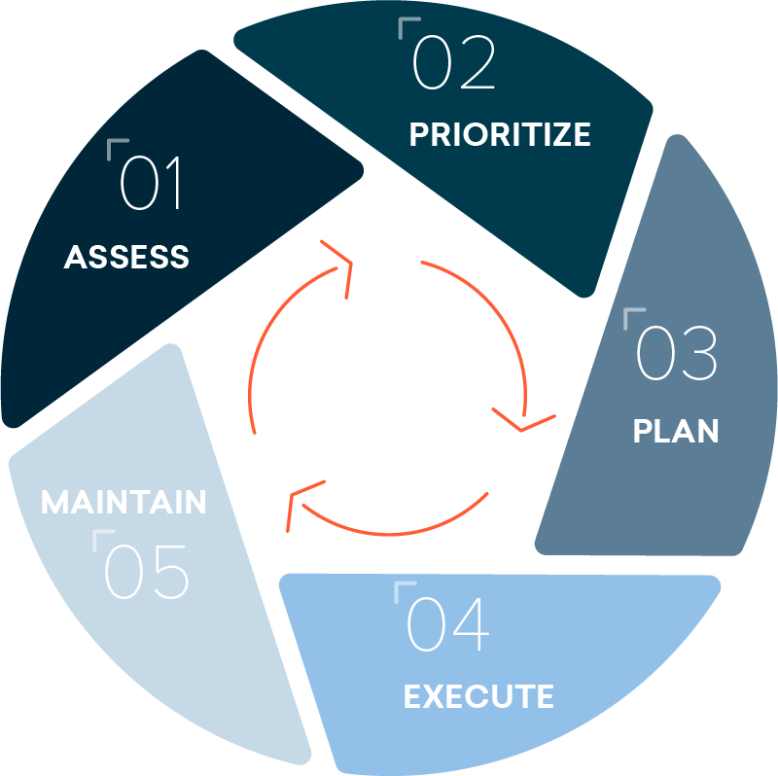A Strategic Guide to Energy Management Preparedness
Energy management readiness is about more than just “having a contingency plan.” It’s a strategic approach that ensures your energy operations remain reliable and efficient, under any circumstances.
The aim is to develop proactive strategies that not only optimize energy consumption, but streamline operations to avoid potential energy service disruptions.
At the heart of this readiness are three key pillars: people, processes, and technology. When these elements are integrated and used effectively, they allow organizations to enhance operational efficiency, reduce costs, and achieve sustainability goals, providing a strong foundation for successful energy management.
Benefits of energy management
No matter where you are in the process, your organization or department can benefit from any efforts made toward energy efficiency and management.
According to Brightly’s 2025 State of U.S. Asset & Facilities Management Report, 51% of respondents acknowledged using asset lifecycle management (ALM) systems to reduce environmental impact, and 94% have implemented renewal energy projects.
Investing in building energy management software can give you a 360-degree view of energy usage data to help on many operational fronts:
- Cut costs on utility bills and identify energy waste
- Improve operational efficiency and sustainability initiatives
- Prove and communicate successes to stakeholders
- Make better decisions and prioritize action
With this foundation in place, the first key pillar, people, becomes even more essential. Having the right team to support your energy management efforts ensures that the strategies you implement are not just effective but sustainable in the long-term.
Harnessing people power
The foundation of energy responsibility starts with people. Our 2025 report findings show that organizations today are making a concerted effort to reduce utility waste and create a culture of environmental awareness while seeing active support from employees. It’s become clear that a quiet "conservation army" exists within our facilities. To unlock this potential, consider these actions:
- Identify your conservation army: Create opportunities for diverse voices to contribute ideas, spot inefficiencies, and help conserve energy. This might include forming a “green council” of volunteers, meeting regularly to review utility usage trends, and brainstorming awareness campaigns.
- Empower your team: Ensure that leaders, such as building operators, have the tools, expertise, and confidence to lead energy initiatives effectively. Invest in professional development, training, and certifications. Hiring a certified energy manager (CEM) can also drive significant energy and cost savings.
- Celebrate successes: Foster enthusiasm by celebrating wins, both big and small. Simple recognition methods – like newsletter highlights, employee recognition programs, or allowing departments to reinvest a portion of energy savings into future projects – can keep momentum high and motivate further action.
Strategic processes: The APPEM model
The most important part of being prepared is having a plan – and a good process. The APPEM model (Assess, Prioritize, Plan, Execute, Maintain) provides a scalable framework for continuous improvement. Whether you’re a small organization with a few local facilities, or a multi-site portfolio with a team of energy engineers, APPEM should be your go-to.
Step 1: Assess
You might have heard the saying, “You can’t manage what you don’t measure.” A solid energy management readiness plan is built on the consistent tracking of utility data to identify cost savings, spikes in usage, and even billing inaccuracies.
A robust energy manager software (EMS) system helps track infrastructure and utility data, monitor consumption patterns, and establish baselines to improve outcomes. Start with major/critical infrastructure first – your biggest and most heavily used or occupied buildings.
You should be able to answer questions like:
- What is the raw data of my organization’s utility consumption?
- At what facility are we using the most utility resources?
- What utility services cost us the most to use?
- What is typical energy consumption at a similar facility?

Step 2: Prioritize
Building and energy managers face a complex balancing act, including managing occupant comfort complaints, rising utility costs, extreme weather conditions, and aging asset lifecycles.
To navigate these challenges, start by clearly defining your goals based on operational objectives and industry demands.
Set simple, achievable targets for the first year to secure buy-in from building occupants and stakeholders. For example, in healthcare facilities leaders might prioritize comfort complaints and address any temperature or humidity issues.
Or you might consider operational adjustments or capital improvements, such as upgrading insulation or HVAC systems. Another goal to prioritize should be evaluating your carbon emissions impact and implementing renewable energy initiatives to reduce your environmental footprint.
Action item: Keep track of compliance reporting and inspections. Establish or revisit sustainability goals such as net-zero operations by 2030, to reduce Scope 3 emissions by 30% by 2030, and reach net-zero greenhouse gas emissions by 2050.
Steps 3 & 4: Plan & execute
Planning and execution are the most straightforward and actionable steps in your energy management strategy. You might be implementing stakeholder communication methods, coordinating contractors and project timelines, maintaining occupant comfort, and minimizing any energy outages.
Here are a few tips to help you get started by focusing on quick wins:
- Schedule consistent preventive maintenance with your computerized maintenance management system (CMMS) to extend asset lifecycles and reduce downtime.
- Ensure all asset maintenance histories are documented digitally in your CMMS.
- Implement an industry-standard, third-party process for measurement and verification before project completion to quantify energy and cost savings.
Action item: Create, manage, and maintain facility checklists and walkthrough procedures for maintenance staff to maximize energy savings.
Step 5: Maintain
Last but not least, measure your results and adjust strategies as needed. Effectively communicate these results to your employees and the stakeholders who make or influence investment decisions.
With the help of your CMMS, you can easily create configurable views, reports, charts, and graphs to showcase usage, cost, carbon emissions, budget data, billing information, and avoided cost.
Remember the conservation army? Studies show that people want to work for sustainable energy organizations that solve problems and achieve goals. So increased communication surrounding your plan can let them know that they do.
Action item: Establish regular follow-up cadence on the results of your organization’s energy strategy, whether quarterly, biannually, or annually.
Energy management technology solutions
Does your organization have an energy management strategy that considers multiple end goals like indoor air-quality mandates, energy, and carbon emissions reduction? Effective energy management is easiest when it’s supported by cloud-based software that can streamline operations, schedule proactive maintenance, and provide data-driven insights.
Here are some examples:
Building Automation Systems (BAS): Integrated BAS solutions automate and optimize building operations by managing HVAC, lighting, and access control systems. While the initial investment can be high, BAS systems can potentially yield significant energy savings of 10%–25% across the building, often paying for themselves within 3–5 years, according to the American Council for an Energy-Efficient Economy (ACEEE).
Internet of Things (IoT) Automation: Beyond basic maintenance scheduling, IoT-enabled systems provide advanced predictive maintenance capabilities, including real-time monitoring through sensors and digital twins. These technologies allow for reporting on asset conditions to prevent failures before they occur.
Energy Management Software: Energy management platforms help track utility usage across various types of energy consumption, from electricity and gas to steam and water. These tools serve as a central hub for utility data, enabling streamlined reporting and reducing the need for manual data entry. This saves time, allowing your team to focus on energy-saving initiatives that align with your goals.
Data-driven insights are critical for building and energy managers. Whether you're streamlining capital expenditure requests, meeting regulatory or investor demands for carbon emissions reporting, or justifying sustainability initiatives, having the right technology solutions is vital for success.
Conclusion
Efficient energy management requires a balanced approach that connects people, processes, and technology to prioritize actions and improve outcomes. Organizations that integrate these pillars can achieve sustainable energy savings while optimizing processes and minimizing disruptions.
Simple energy management solutions provide the necessary utility data to support better decisions and justify asset lifecycle improvements. Start small, build momentum, and celebrate wins along the way.
Learn more about how Brightly’s Energy Manager helps organizations prioritize action, make smarter operational decisions, and centralize utility management. It even helped a Utah school district win the 2024 Utah Energy Champion Award.
And for commercial real estate firms seeking software solutions, Brightly’s Stream is your go-to foundation for energy and sustainability programs, net-zero carbon plans, and ESG reporting. In just two years, Warrington PCI Management (WPM) in Vancouver saved $125,000 in utility costs, reduced greenhouse gas emissions by 31%, and improved their ENERGY STAR score by 43 points.


